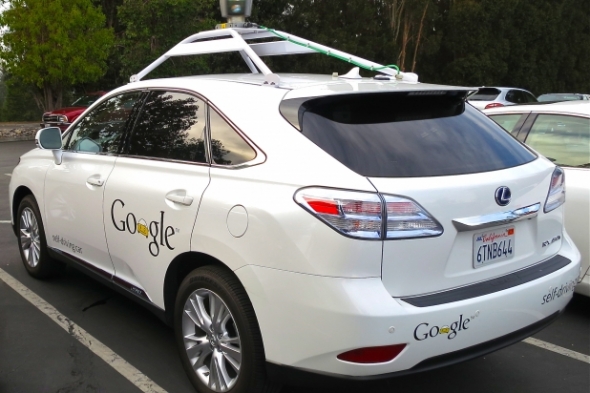- We can reduce traffic accidents by 90%.
- We can reduce wasted commute time and energy by 90%.
- We can reduce the number of cars by 90%.
 The driverless car could reduce the need for cars by enabling efficient sharing of vehicles. A driverless vehicle could theoretically be shared by multiple people, delivering itself when and where it is needed, parking itself in some remote place whenever it’s not in use.
A car is often a person’s second largest capital expenditure, after a home, yet a car sits unused some 95% of the time. With the Google car, people could avoid the outlay of many thousands of dollars, or tens of thousands, on an item that mostly sits and, instead, simply pay by the mile.
A study led by Lawrence Burns and William Jordon at Columbia University’s Earth Institute Program on Sustainable Mobility showed the dramatic cost savings potential. Their analysis found that a shared, driverless fleet could provide far better mobility experiences than personally owned vehicles at far radically lower cost. For medium-sized cities like Ann Arbor, MI, the cost per trip-mile could be reduced by 80% when compared to personally own vehicles driven about 10,000 miles per year -- without even factoring in parking and the opportunity cost of driving time. Their analysis showed similar cost savings potential for suburban and high-density urban scenarios, as well.
The driverless car could reduce the need for cars by enabling efficient sharing of vehicles. A driverless vehicle could theoretically be shared by multiple people, delivering itself when and where it is needed, parking itself in some remote place whenever it’s not in use.
A car is often a person’s second largest capital expenditure, after a home, yet a car sits unused some 95% of the time. With the Google car, people could avoid the outlay of many thousands of dollars, or tens of thousands, on an item that mostly sits and, instead, simply pay by the mile.
A study led by Lawrence Burns and William Jordon at Columbia University’s Earth Institute Program on Sustainable Mobility showed the dramatic cost savings potential. Their analysis found that a shared, driverless fleet could provide far better mobility experiences than personally owned vehicles at far radically lower cost. For medium-sized cities like Ann Arbor, MI, the cost per trip-mile could be reduced by 80% when compared to personally own vehicles driven about 10,000 miles per year -- without even factoring in parking and the opportunity cost of driving time. Their analysis showed similar cost savings potential for suburban and high-density urban scenarios, as well.
 Driving could become Zipcar writ large (except the car comes to you).
Looking worldwide, the statistics are less precise, but the potential benefits are even more startling. The World Health Organization estimates that more than 1.2 million people are killed on the world’s roads each year, and as many as 50 million others are injured. And the WHO predicts that the problems will only get worse. It estimates that road traffic injuries will become the fifth leading cause of worldwide death by 2030, accounting for 3.6% of the total -- rising from the ninth leading cause in 2004, when it accounted for 2.2% of the world total.
If Google could give everyone a world-class electronic driver, it would drastically reduce the deaths, injuries and direct costs of accidents. The driverless car might also save developing countries from ever having to replicate the car-centric infrastructure that has emerged in most Western countries. This leapfrogging has already happened with telephone systems: Developing countries that lacked land-line telephone and broadband connectivity, such as India, made the leap directly to mobile systems rather than build out their land-line infrastructures.
China alone expects to invest almost $800 billion on road and highway construction between 2011 and 2015. It is doubtful, however, whether even this massive investment can keep up with the rising accidents and traffic congestion that the country endures. And road construction won’t deal with the issue of pollution, to which the massive car buildup contributes and which is becoming an ever more politically sensitive issue.
How might China and other developing economic powers’ massive car-related investments be redeployed if fundamental assumptions were viewed through the lens of the driverless car?
In sum, the Google driverless car not only makes for a great demo; it has worldwide social and economic benefits that could amount to trillions of dollars per year.
Insurers will feel major effects because hundreds of billions of dollars of reductions in losses obviously mean reduced requirements for insurance in all sorts of areas: auto, life, P&C, health and more; even workers' comp needs will diminish because so many claims that would have stemmed from car accidents simply won't happen. The locus of power in some parts of the insurance industry will shift, too. Why should a driver buy insurance if the car is doing the driving? Instead, car makers will likely take on the responsibility, and perhaps as part of their traditional approach to product liability, rather than working through auto insurance companies as they are currently constituted. I'll look at those issues and others next time.
Driving could become Zipcar writ large (except the car comes to you).
Looking worldwide, the statistics are less precise, but the potential benefits are even more startling. The World Health Organization estimates that more than 1.2 million people are killed on the world’s roads each year, and as many as 50 million others are injured. And the WHO predicts that the problems will only get worse. It estimates that road traffic injuries will become the fifth leading cause of worldwide death by 2030, accounting for 3.6% of the total -- rising from the ninth leading cause in 2004, when it accounted for 2.2% of the world total.
If Google could give everyone a world-class electronic driver, it would drastically reduce the deaths, injuries and direct costs of accidents. The driverless car might also save developing countries from ever having to replicate the car-centric infrastructure that has emerged in most Western countries. This leapfrogging has already happened with telephone systems: Developing countries that lacked land-line telephone and broadband connectivity, such as India, made the leap directly to mobile systems rather than build out their land-line infrastructures.
China alone expects to invest almost $800 billion on road and highway construction between 2011 and 2015. It is doubtful, however, whether even this massive investment can keep up with the rising accidents and traffic congestion that the country endures. And road construction won’t deal with the issue of pollution, to which the massive car buildup contributes and which is becoming an ever more politically sensitive issue.
How might China and other developing economic powers’ massive car-related investments be redeployed if fundamental assumptions were viewed through the lens of the driverless car?
In sum, the Google driverless car not only makes for a great demo; it has worldwide social and economic benefits that could amount to trillions of dollars per year.
Insurers will feel major effects because hundreds of billions of dollars of reductions in losses obviously mean reduced requirements for insurance in all sorts of areas: auto, life, P&C, health and more; even workers' comp needs will diminish because so many claims that would have stemmed from car accidents simply won't happen. The locus of power in some parts of the insurance industry will shift, too. Why should a driver buy insurance if the car is doing the driving? Instead, car makers will likely take on the responsibility, and perhaps as part of their traditional approach to product liability, rather than working through auto insurance companies as they are currently constituted. I'll look at those issues and others next time.





